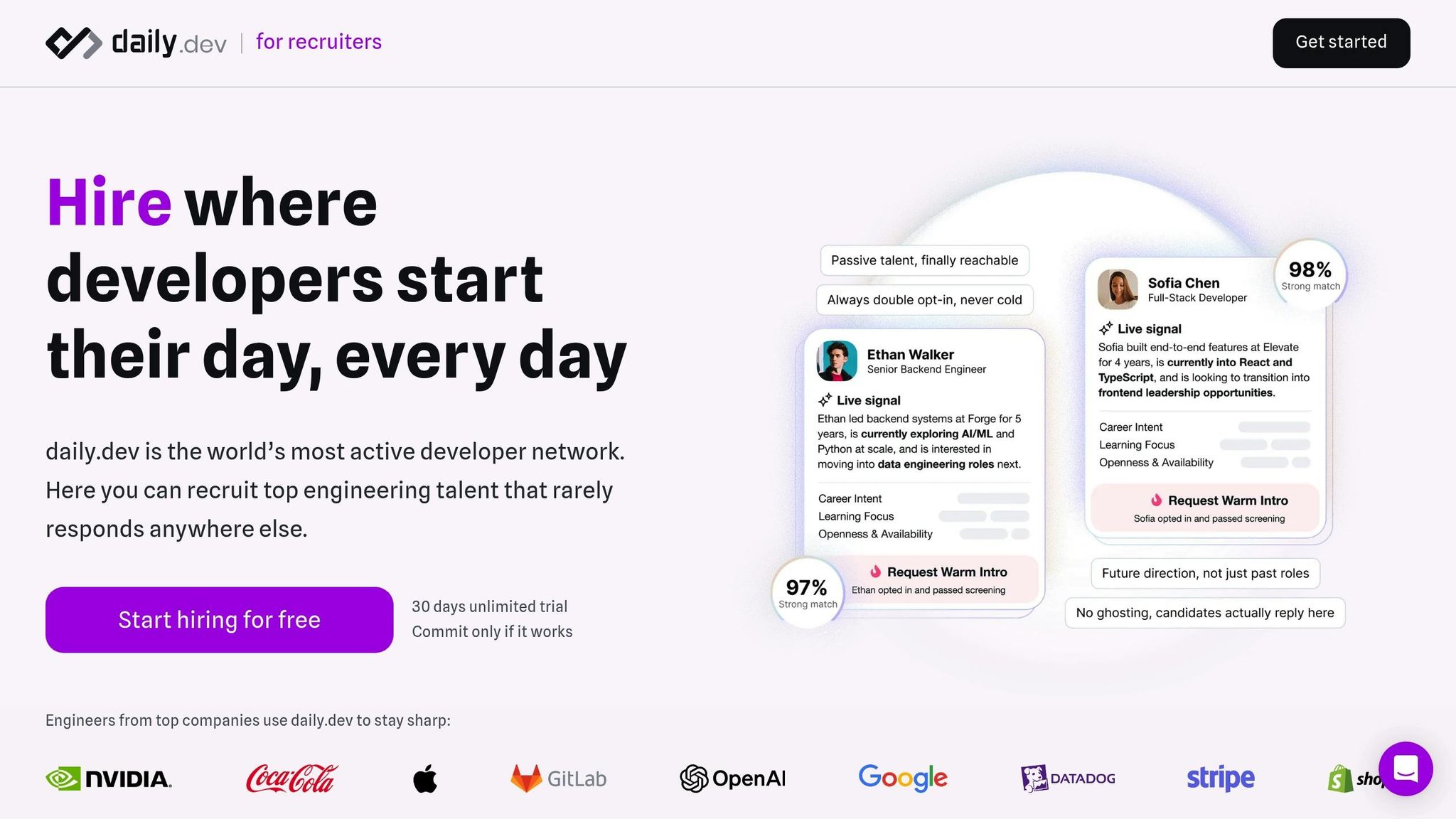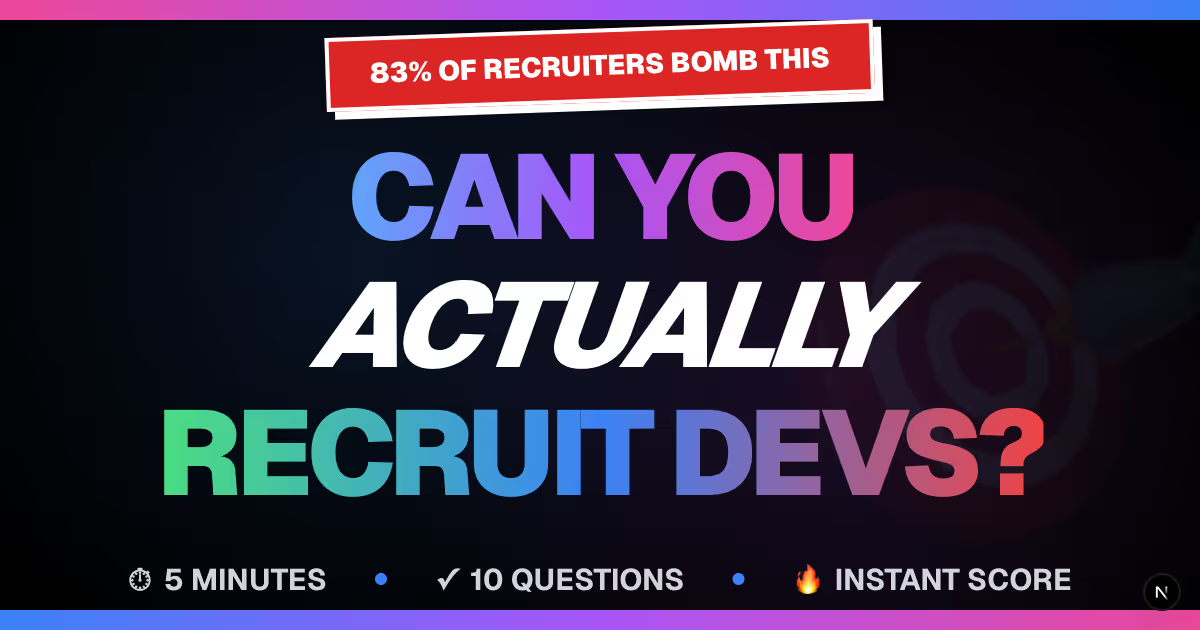


Building diverse talent pipelines is essential for innovation and success in tech, enhancing team performance and market outcomes.
Diverse talent pipelines are key to building stronger tech teams. They help companies find skilled developers often missed by outdated hiring methods, leading to better innovation, decision-making, and market performance. Here's why they matter and how to implement them effectively:
- Broader Talent Access: Engages a global pool of developers, including passive candidates and underrepresented groups.
- Improved Team Performance: Teams with varied perspectives create more inclusive products and solve problems more effectively.
- Higher Engagement Rates: Platforms like daily.dev report reply rates of up to 85–90% through double opt-in introductions.
To succeed, companies should focus on fair hiring practices, leverage global remote work, invest in career growth, and build trust with developer communities. Tools like daily.dev Recruiter streamline this process by connecting companies with active, engaged talent.
Key Takeaway: Embracing diverse hiring practices isn't just ethical - it drives better business outcomes. Start by analyzing gaps, revising hiring methods, and using platforms that prioritize trust and engagement.
Diversity & Inclusion in Tech Recruitment: Best Practices & Strategies
The Business Case for Diversity in Tech Teams
Diversity isn't just a moral imperative - it’s a savvy business move. Companies that actively pursue diverse talent pools can tap into fresh perspectives that drive innovation, improve financial outcomes, and foster stronger team collaboration. Let’s explore how diversity directly impacts a company’s success and internal operations.
Impact on Innovation and Creativity
When people from different backgrounds come together, they bring unique viewpoints that can spark creative solutions. Diverse teams often tackle problems from multiple angles, leading to ideas that might not surface in more homogenous groups. For instance, developers with varied life experiences are more likely to anticipate and address the needs of different users. This often results in products that are more inclusive, such as those with built-in accessibility features right from the start.
Boosting Financial Performance
There’s clear evidence that diversity pays off financially. Teams with broader perspectives often develop products that resonate with a wider audience, which can lead to better customer engagement and stronger market performance. By prioritizing diversity in hiring, companies position themselves to create solutions that appeal to a broader customer base, driving growth and profitability.
Strengthening Team Dynamics and Decision-Making
Diversity doesn’t just enhance innovation - it also improves how teams work together and make decisions. Groups with mixed perspectives tend to have richer discussions, carefully weigh options, and anticipate potential roadblocks more effectively. This collaborative approach fosters stronger decision-making and helps teams identify and address challenges before they escalate.
Strategies for Building and Maintaining Diverse Talent Pipelines
Creating a truly diverse talent pipeline requires deliberate changes to how hiring and development are approached. Companies that succeed in this area focus on reducing bias, expanding their candidate pool, and fostering growth opportunities at all levels.
Building Fair Hiring Practices
Traditional hiring methods can unintentionally exclude diverse candidates. To counter this, organizations should start by crafting job descriptions that are clear, skill-focused, and free from unnecessary qualifications. These descriptions should emphasize essential responsibilities and be reviewed to ensure they appeal to candidates from a variety of backgrounds.
Structured interviews are another key step. By focusing on role-specific questions and technical skills, companies can reduce subjectivity and move away from vague notions like "culture fit." Transparency is equally important - clearly outlining the role, team dynamics, and workplace environment helps candidates determine if the position aligns with their goals.
Companies can further expand access to diverse talent by looking beyond local markets, especially when adopting remote work options.
Leveraging Remote and Hybrid Work Models
Remote and hybrid work setups remove geographic barriers, allowing companies to tap into a global talent pool. According to daily.dev, 1 in 50 developers worldwide is active on their platform, offering access to a vast network of skilled professionals. Notably, 90% of these developers typically do not engage with traditional outreach methods, making remote hiring a valuable strategy.
To make remote hiring inclusive, processes should accommodate different time zones and communication preferences. Flexibility in these areas ensures that talented candidates from around the world can participate effectively.
Supporting Talent Across Career Stages
Achieving lasting diversity requires more than hiring - it involves continuous investment in talent development. Mentorship programs and targeted upskilling initiatives can help employees grow and thrive within the organization.
Upskilling programs, designed with input from the communities they aim to support, not only align with company goals but also empower individuals to expand their skill sets. Leadership development programs are particularly critical for advancing diverse talent into senior roles. This is especially relevant given that 40% of the daily.dev network comprises senior contributors and leaders.
Companies should also embrace alternative pathways into tech roles. Bootcamp graduates, self-taught developers, and career changers bring fresh perspectives and valuable skills that enrich teams. By broadening entry points, organizations can tap into a wider range of talent.
Retention is just as important as recruitment. Providing clear pathways for career progression, along with the necessary resources for advancement, helps employees envision long-term growth within the company. When teams feel supported and see opportunities to advance, they contribute to a more dynamic and inclusive workplace. This focus on growth and opportunity strengthens innovation and adaptability - key drivers of success in the tech world.
sbb-itb-d1e6221
Building Relationships with Diverse Developer Communities
Attracting diverse talent goes beyond simply posting job openings and hoping for the best. Building genuine connections with developer communities takes time, trust, and meaningful engagement. This approach transforms recruiting into a two-way street that benefits both parties.
The Role of Trust and Genuine Engagement
Trust is the cornerstone of any strong relationship with developer communities. Unfortunately, traditional recruiting methods often erode this trust. Cold outreach, irrelevant job offers, and impersonal interactions can quickly alienate potential candidates. Developers frequently encounter frustrations like unclear job descriptions, lack of follow-up after interviews, and inefficient screening processes that waste their time.
To build trust, organizations need to rethink their approach. Instead of bombarding developers with generic messages, successful companies connect with them in environments where they already feel comfortable and respected.
When developers are treated as professionals with unique goals and interests, they’re more likely to engage in meaningful conversations about career opportunities. Providing clear, detailed role descriptions upfront avoids mismatches and sets realistic expectations. Additionally, showing genuine interest in a developer’s current skills, career path, and aspirations demonstrates respect and fosters deeper connections.
This foundation of trust paves the way for tools like daily.dev Recruiter to turn these connections into real hiring success.
How daily.dev Recruiter Supports Diverse Hiring

The principles of trust and meaningful engagement are embedded in the design of daily.dev Recruiter, turning them into actionable hiring strategies. The platform thrives on an active professional network where developers come to learn, grow, and connect. This creates a natural space for authentic relationships to develop.
By using a developer-first approach and leveraging proven engagement metrics, daily.dev Recruiter facilitates trust-based, double opt-in introductions. This ensures high response rates and gives companies access to a global talent pool that spans a variety of backgrounds, skills, and locations.
The platform also addresses common frustrations that often deter diverse candidates from traditional recruiting methods. Job opportunities are discreetly presented to relevant developers, with all necessary context provided upfront. This eliminates unnecessary guesswork and saves time for everyone involved. Through these thoughtful interactions, daily.dev Recruiter strengthens the strategy of building diverse talent pipelines, making the hiring process smoother and more inclusive.
Measuring and Maintaining Diversity Outcomes
Building a diverse talent pipeline is just the starting point. For diversity initiatives to make a meaningful and lasting impact, organizations need to continuously assess and refine their strategies. A data-driven approach can help maintain momentum and identify areas for improvement, ensuring that diversity efforts contribute to both innovation and long-term success.
Tracking Diversity Metrics
To measure progress effectively, start by establishing baseline metrics. Regularly review data on hiring practices, employee development, and inclusion efforts. These metrics provide a clear picture of how well diversity goals are being met and highlight areas that may need adjustment. Ongoing evaluations ensure that strategies evolve to meet changing needs.
Retention and Succession Planning
Tracking numbers is important, but keeping diverse talent engaged and supported is just as crucial. Focus on creating an environment where employees feel valued and have room to grow. This might include revisiting workplace policies, offering accessible career development programs, and ensuring professional growth opportunities are available to everyone. Periodic reviews of these efforts can help identify gaps and create clear pathways for advancement, boosting long-term retention.
Long-Term Impact of Diversity Programs
The real value of diversity initiatives often becomes evident over time. A multi-year evaluation plan can reveal how these efforts shape organizational culture and performance. By examining the long-term effects, companies can refine their strategies to ensure diversity continues to drive innovation and resilience well into the future.
Conclusion: The Future of Diversity in Tech
Research highlights that building diverse talent pipelines is more than just the right thing to do - it’s a smart business move. Companies that prioritize diversity often see improved innovation, stronger financial outcomes, and more adaptable teams. As the tech industry continues to evolve, organizations that fail to prioritize diverse hiring risk falling behind in creativity and progress.
Achieving meaningful change requires more than good intentions. It takes deliberate, structured efforts to identify, engage, and retain talent. The most forward-thinking companies focus on building genuine relationships with diverse developer communities, moving away from outdated recruitment strategies.
Key Takeaways
Diverse talent pipelines can transform how tech teams function and innovate. Beyond fueling creativity, diverse teams contribute to market success and foster inclusive workplace cultures. The shift toward remote and hybrid work models has also created opportunities to access a global talent pool, erasing traditional geographic limitations.
At the core of successful diverse hiring is trust. As recruiting expert Nimrod Kramer puts it, "Trust is the currency of modern recruiting". When developers feel respected and valued during the hiring process, it strengthens relationships and opens doors to top-tier talent.
These insights reinforce the idea that diversity isn’t just a moral imperative - it’s a strategic advantage that drives innovation and elevates performance.
Call to Action for Tech Leaders
The future will favor organizations that take bold and deliberate steps toward diversity. Start by analyzing your current talent pipelines to identify gaps in your approach. Expand your reach by engaging with communities where diverse developers are already active, rather than relying solely on traditional recruiting methods.
Update your screening processes to go beyond standard job descriptions. Use tailored questions that evaluate candidates holistically. Ensure your hiring tools integrate with existing systems to track diversity metrics effectively and maintain accountability in your efforts.
Leverage platforms designed to build trust and foster meaningful engagement with developers. For instance, daily.dev Recruiter connects companies with a global network of developers through warm, double opt-in introductions, achieving reply rates as high as 85–90% in early trials. This trust-first approach attracts top talent that might otherwise bypass conventional recruiting channels.
FAQs
What are the best ways to measure the success of diversity initiatives in tech teams?
Measuring the impact of diversity initiatives in tech teams requires a careful balance of numbers and personal experiences.
On the quantitative side, you’ll want to look at metrics like the percentage of underrepresented groups in your workforce, retention and promotion rates, and pay equity. These figures offer a clear way to see if your efforts are driving measurable change.
But numbers alone don’t tell the whole story. Qualitative insights - gathered through employee surveys, focus groups, or open feedback channels - reveal how inclusive your workplace feels. They help uncover whether team members feel valued, supported, and genuinely part of the team.
The real challenge is to tie these measurements back to your organization’s bigger picture. When done right, diversity efforts should fuel collaboration, spark innovation, and ultimately drive business success.
How can tech companies build trust with diverse developer communities?
Building trust with developers from different backgrounds begins with clear communication and genuine respect. Companies should provide detailed information about roles, expectations, and growth opportunities right from the start. This ensures developers have the full picture before deciding to engage.
Equally important is creating meaningful connections through thoughtful, double opt-in introductions. This method ensures that developers are genuinely interested in the opportunity, making them feel appreciated, while recruiters focus on candidates who are open to discussions. By emphasizing sincerity and intentionality, companies can build a hiring process that earns trust and appeals to a wide range of talented individuals.
How do remote and hybrid work models help tech companies build more diverse teams?
Remote and hybrid work models are transforming how tech companies approach hiring, breaking down geographical barriers and opening the door to a much broader talent pool. By eliminating the need for relocation or daily commutes, businesses can now connect with skilled professionals from regions that were once out of reach.
This approach not only expands access to talent but also encourages diversity by welcoming individuals with varied backgrounds, experiences, and perspectives. With remote and hybrid options, companies can build teams that are more inclusive and dynamic, sparking fresh ideas and innovative thinking. These models make the hiring process fairer and more accessible, ensuring that opportunities are no longer limited by location.
Related Blog Posts








